Oxfordshire Liveable Streets Supports Bold Decongestion Measures!
At Oxfordshire Liveable Streets, our vision is for an Oxford where everyone, whether they drive or not, can get around easily, affordably, and safely. A city where buses are fast and reliable, the air is clean, and our streets are welcoming for children, families, workers, and visitors.
We welcome the County Council’s proposal for a temporary congestion charge. Right now, with Botley Road closed, some of Oxford’s roads are quite often gridlocked, noisy, overheated, and choked with fumes. It’s not good for anyone whether on wheels, on foot, or trying to run a business in town. We urgently need bold decongestion measures that make Oxford work better for everyone. Doing nothing is not an option.
We support the temporary congestion charge because it helps deliver:
Better Journeys: Faster, more reliable journeys for those who genuinely need to drive, better and more dependable buses and taxis for everyone else, and safer roads and crossings for pedestrians and cyclists.
Fairness: Everyone deserves to get around Oxford fairly. This scheme exempts those with the greatest need: unpaid carers, health and community workers, trade vehicles, and Blue Badge holders. The charge is designed to apply primarily to those with the capacity to choose alternatives.
Freedom to Choose: Decongestion expands choice, it doesn’t restrict it. Right now, congestion slows down buses, making them less reliable and more expensive. This forces people back into cars, adding to the traffic and making conditions worse for everyone, including cyclists and pedestrians. By decongesting the roads, we create the conditions for cleaner, quicker, and more affordable ways to get around.
Health and Wellbeing: Less traffic means cleaner air, safer streets, and more space to move, play, do business, and connect.
Oxfordshire Liveable Streets Strongly Support:
Weight-based charging: Larger, heavier vehicles are more polluting, more dangerous to other road users, and take up more space on our streets. They also cause more wear and tear on road infrastructure. A weight-based charge is fairer — those most able to pay more, do.
Using revenue to support cheaper fares, more routes, and more reliable service: This is a critical equity measure. Revenue from the charge can make buses more affordable, more available, and more dependable — especially for those who rely on them most. Reinvesting in reduced fares, expanded routes, and better reliability helps level the playing field and ensures fairer access to our city.
Stronger incentives to switch: The charge needs to be a real incentive to shift modes — especially when the alternative (a day bus ticket or park & ride for two people) already costs more. A higher charge makes the choice to switch easier, more attractive, and more equitable.
Implementing recommendations from Oxford’s Citizens’ Assembly: The Citizens’ Assembly, made up of residents from all walks of life, overwhelmingly supported bold action to improve transport and reduce car dominance. 88% backed the creation of a car-free city centre, and 88% supported dedicating roads to buses, emergency vehicles, taxis, Blue Badge holders and cyclists. Their support reflects what happens when everyday people are given time, space, and good information to reflect: they choose bold, fair, future-focused change.
This is about more than traffic. Decongestion is a necessary step in creating the conditions for a more inclusive, connected, and climate-resilient Oxford. While it may feel like a “stick,” it’s actually how we clear space for the “carrot”: reliable buses, safer cycling, more equitable access to the city. If we’re serious about a future-fit Oxford, then we need to back the tools that make that future possible — starting now.
We invite all residents, businesses and organisations who share our values to respond to the proposed Temporary Congestion Charge Consultation. We have prepared a simple Response Guide for those who’d like support completing a response.
In addition, please help us show broad, cross-sector support for decongestion by signing this Open Letter.
The consultation ends Sunday 3 August at midnight and the Open Letter will remain open for new signatures from businesses, organisations, community groups, and residents throughout the consultation period.

